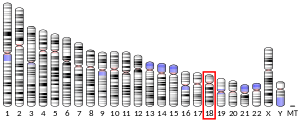PIK3C3
Phosphatidylinositol 3-kinase catalytic subunit type 3 is an enzyme that in humans is encoded by the PIK3C3 gene.[5][6]
References
- GRCh38: Ensembl release 89: ENSG00000078142 - Ensembl, May 2017
- GRCm38: Ensembl release 89: ENSMUSG00000033628 - Ensembl, May 2017
- "Human PubMed Reference:". National Center for Biotechnology Information, U.S. National Library of Medicine.
- "Mouse PubMed Reference:". National Center for Biotechnology Information, U.S. National Library of Medicine.
- Volinia S, Dhand R, Vanhaesebroeck B, MacDougall LK, Stein R, Zvelebil MJ, Domin J, Panaretou C, Waterfield MD (Sep 1995). "A human phosphatidylinositol 3-kinase complex related to the yeast Vps34p-Vps15p protein sorting system". EMBO J. 14 (14): 3339–48. PMC 394401. PMID 7628435.
- "Entrez Gene: PIK3C3 phosphoinositide-3-kinase, class 3".
Further reading
- Lee C, Liu QH, Tomkowicz B, et al. (2004). "Macrophage activation through CCR5- and CXCR4-mediated gp120-elicited signaling pathways". J. Leukoc. Biol. 74 (5): 676–82. doi:10.1189/jlb.0503206. PMID 12960231.
- Vogel LB, Fujita DJ (1994). "The SH3 domain of p56lck is involved in binding to phosphatidylinositol 3'-kinase from T lymphocytes". Mol. Cell. Biol. 13 (12): 7408–17. PMC 364812. PMID 7504174.
- Milani D, Mazzoni M, Borgatti P, et al. (1996). "Extracellular human immunodeficiency virus type-1 Tat protein activates phosphatidylinositol 3-kinase in PC12 neuronal cells". J. Biol. Chem. 271 (38): 22961–4. doi:10.1074/jbc.271.38.22961. PMID 8798481.
- Bonaldo MF, Lennon G, Soares MB (1997). "Normalization and subtraction: two approaches to facilitate gene discovery". Genome Res. 6 (9): 791–806. doi:10.1101/gr.6.9.791. PMID 8889548.
- Panaretou C, Domin J, Cockcroft S, Waterfield MD (1997). "Characterization of p150, an adaptor protein for the human phosphatidylinositol (PtdIns) 3-kinase. Substrate presentation by phosphatidylinositol transfer protein to the p150.Ptdins 3-kinase complex". J. Biol. Chem. 272 (4): 2477–85. doi:10.1074/jbc.272.4.2477. PMID 8999962.
- Mazerolles F, Barbat C, Fischer A (1997). "Down-regulation of LFA-1-mediated T cell adhesion induced by the HIV envelope glycoprotein gp160 requires phosphatidylinositol-3-kinase activity". Eur. J. Immunol. 27 (9): 2457–65. doi:10.1002/eji.1830270946. PMID 9341793.
- Borgatti P, Zauli G, Colamussi ML, et al. (1998). "Extracellular HIV-1 Tat protein activates phosphatidylinositol 3- and Akt/PKB kinases in CD4+ T lymphoblastoid Jurkat cells". Eur. J. Immunol. 27 (11): 2805–11. doi:10.1002/eji.1830271110. PMID 9394803.
- Borgatti P, Zauli G, Cantley LC, Capitani S (1998). "Extracellular HIV-1 Tat protein induces a rapid and selective activation of protein kinase C (PKC)-alpha, and -epsilon and -zeta isoforms in PC12 cells". Biochem. Biophys. Res. Commun. 242 (2): 332–7. doi:10.1006/bbrc.1997.7877. PMID 9446795.
- Milani D, Mazzoni M, Zauli G, et al. (1998). "HIV-1 Tat induces tyrosine phosphorylation of p125FAK and its association with phosphoinositide 3-kinase in PC12 cells". AIDS. 12 (11): 1275–84. doi:10.1097/00002030-199811000-00008. PMID 9708406.
- Jauliac S, Mazerolles F, Jabado N, et al. (1998). "Ligands of CD4 inhibit the association of phospholipase Cgamma1 with phosphoinositide 3 kinase in T cells: regulation of this association by the phosphoinositide 3 kinase activity". Eur. J. Immunol. 28 (10): 3183–91. doi:10.1002/(SICI)1521-4141(199810)28:10<3183::AID-IMMU3183>3.0.CO;2-A. PMID 9808187.
- Park IW, Wang JF, Groopman JE (2001). "HIV-1 Tat promotes monocyte chemoattractant protein-1 secretion followed by transmigration of monocytes". Blood. 97 (2): 352–8. doi:10.1182/blood.V97.2.352. PMID 11154208.
- Zauli G, Milani D, Mirandola P, et al. (2001). "HIV-1 Tat protein down-regulates CREB transcription factor expression in PC12 neuronal cells through a phosphatidylinositol 3-kinase/AKT/cyclic nucleoside phosphodiesterase pathway". FASEB J. 15 (2): 483–91. doi:10.1096/fj.00-0354com. PMID 11156964.
- Deregibus MC, Cantaluppi V, Doublier S, et al. (2002). "HIV-1-Tat protein activates phosphatidylinositol 3-kinase/ AKT-dependent survival pathways in Kaposi's sarcoma cells". J. Biol. Chem. 277 (28): 25195–202. doi:10.1074/jbc.M200921200. PMID 11994280.
- Cook JA, August A, Henderson AJ (2002). "Recruitment of phosphatidylinositol 3-kinase to CD28 inhibits HIV transcription by a Tat-dependent mechanism". J. Immunol. 169 (1): 254–60. doi:10.4049/jimmunol.169.1.254. PMID 12077252.
- Strausberg RL, Feingold EA, Grouse LH, et al. (2003). "Generation and initial analysis of more than 15,000 full-length human and mouse cDNA sequences". Proc. Natl. Acad. Sci. U.S.A. 99 (26): 16899–903. doi:10.1073/pnas.242603899. PMC 139241. PMID 12477932.
- François F, Klotman ME (2003). "Phosphatidylinositol 3-kinase regulates human immunodeficiency virus type 1 replication following viral entry in primary CD4+ T lymphocytes and macrophages". J. Virol. 77 (4): 2539–49. doi:10.1128/JVI.77.4.2539-2549.2003. PMC 141101. PMID 12551992.
- Vergne I, Chua J, Deretic V (2003). "Tuberculosis toxin blocking phagosome maturation inhibits a novel Ca2+/calmodulin-PI3K hVPS34 cascade". J. Exp. Med. 198 (4): 653–9. doi:10.1084/jem.20030527. PMC 2194170. PMID 12925680.
- Khan NA, Di Cello F, Nath A, Kim KS (2004). "Human immunodeficiency virus type 1 tat-mediated cytotoxicity of human brain microvascular endothelial cells". J. Neurovirol. 9 (6): 584–93. doi:10.1080/jnv.9.6.584.593. PMID 14602571.
This article is issued from Wikipedia. The text is licensed under Creative Commons - Attribution - Sharealike. Additional terms may apply for the media files.





